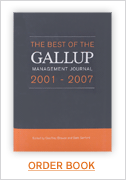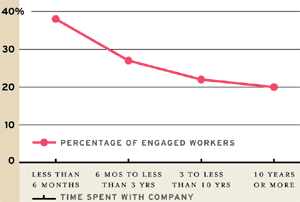Meet Joe the company man. Joe has been with the company for nearly 25 years. While in high school, he worked summers in the mailroom; during college he helped out the analysts as a researcher; and when he graduated from college, he became an analyst. From there, he moved up to associate, and now a wife and two kids later, Joe is a vice president of the company.
 |
But here's a secret: You would think that loyalty to one company for so many years would be a sure sign that Joe is a happy employee. But Joe hates his job. And he's not alone.
Through analysis of its database of 1.4 million employees in 66 countries, Gallup researchers have identified an inverse relationship between employee engagement, or the degree to which a worker is fulfilled by his or her job, and length of service, or the number of years he or she has been with the company. That means that, for most employees, the first year on the job is their best. It's downhill from there for the worker and for the company as well, because disengaged employees are a drag on profit and sales and overall satisfaction among customers. (Gallup measures engagement through the Q12, a 12-question survey that asks employees to rate the quality of their workplace. For a list of the 12 questions, see graphic "The 12 Elements of Great Managing.")
 |
Frankly, this finding surprised Gallup researchers. We expected to see an increasing sense of belonging over time. New hires, we figured, would be tentative, unsure of what to expect from their jobs, their managers and their co-workers. But as time passed, we assumed that their uncertainty would diminish and companies would see engagement ratings rise as managers helped new workers identify their talents, learn skills and move into roles that drew upon their particular strengths. But that's not what happens.
The problem, it turns out, is this: though companies may recognize how crucial it is to engage their workers and may even acknowledge that it must be an ongoing process, the essential principles of employee engagement have not become ingrained in management practices. It's one thing to accept that employees aren't interchangeable cogs in a wheel, but it's quite another to make sure that every part of an organization is set up to appreciate their specific talents and to direct those talents to best serve the company's objectives.
Clearly, the inverse relationship between engagement and length of service suggests a disconnect between how businesses intend to treat their workers and how workers feel about their jobs. That implies that much of the time and money companies invest in developing their employees and managers may be counterproductive. Instead of honoring and capitalizing on the strengths of employees, companies continually remind workers of their shortcomings through training programs that focus on fixing an employee's weaknesses. And this can lead to a disengaged workforce.
Great managers drive engagement up over time by developing employees around their strengths. They do this by providing employees with a clear mission and by helping them think about how to apply their strengths to those outcomes. The best managers figure out strategies for managing a weakness so that it isn't a barrier to achieving the outcome.
|
|
 |
Take Bill, a supervisor in the claims department of an insurance company. After three years as a supervisor, Bill felt that he had slowly become less engaged, and was close to leaving the company. He was constantly being criticized by his manager for not spending enough time with his staff. Although Bill did a great job with the claims work, his manager continued to focus on this one shortcoming. Just as Bill was ready to quit, he got a new manager.
The new manager asked for a meeting at which Bill confessed that although he liked the people on his staff, he was having difficulty finding time to connect with them. The only advice he had ever received from his old boss was to try harder. The new manager asked Bill to describe some of the things he did each day. He quickly discovered that Bill was a list-maker who zeroed in on his list every day until each item was checked off. His new manager's simple solution was to add one staff member's name to the top of that list each day. Bill's job was to check in on that person before the end of the day to see how things were going. This worked beautifully. Today, two years later, Bill is still with the company and feeling more engaged than ever.
The new manager helped Bill move from being disengaged to being fully engaged in his work. But the manager is not the only one who bears responsibility for capitalizing on each person's strengths. Since fit, or positioning someone based on their strengths, is about identifying organizational needs and exercising employee strengths, it's also up to the employee to figure out how best to apply his or her talents to become more fully engaged at work.
For instance, as a territory manager for Stryker Medical, Tom Dillis sells hospital equipment in the Pittsburgh area. He's good at it, he knows it, and he recognizes why his strengths account for his success. "My strength is my ability to form personal relationships," says Dillis, "and I use that strength with my customers." For many workers like Dillis, understanding personal strengths raises engagement. And once employees know what they do best, they can guide their managers in creating the right opportunities for them.
To beat the odds of the inverse relationship between employee engagement and length of service, make sure your managers understand the idea of human strengths. Make sure they enable every employee to identify his or her natural talents. And then don't be surprised to find that employees take pride in exercising their strengths to make their unique contributions to the organization.
If the challenges of managing human assets have taught us anything, it's that standardizing human nature doesn't work. If you want the productive talents of your employees to work for you over time, start by understanding those talents rather than quashing them.
 |